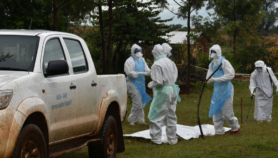By: Zablon Odhiambo
Send to a friend
The details you provide on this page will not be used to send unsolicited email, and will not be sold to a 3rd party. See privacy policy.
[NAIROBI] Malaria epidemics could be predicted up to five months ahead using a special combination of climate models, say researchers.
In a study published by Nature today (1 February), Tim Palmer of the UK-based European Centre for Medium Range Weather Forecasts and colleagues say the predictions could be used to strategically target insecticides and drugs to regions at risk of an outbreak.
The study was based on an early-warning system developed by Botswana’s National Malaria Control Programme. The system uses information about rainfall, health surveillance and the population’s vulnerability to malaria to detect unusual changes in seasonal patterns of disease.
By using a combination of climate models, Palmer’s team eliminated uncertainties in the system’s predictions. To prove their new approach, they tried retrospectively predicting malaria epidemics in Botswana from 1982 to 2002.
The method showed "very substantial levels of predictive skill", says Palmer.
The team found that the risk of an epidemic in Botswana rises just after a season of heavy rainfall and that temperature and rainfall drive the abundance of both mosquitoes and parasites.
"This study demonstrates that judicious use of climate information is an important factor in reducing the impact of this devastating disease," says Charles Delacollette of the WHO Global Malaria Programme.
Palmer points out that his team’s method only applies to areas where malaria occurs in climate-related epidemics and not in areas where the disease is a year-round problem.
Although epidemic malaria accounts for only a small proportion of cases worldwide, it can be important at a regional level, contributing to a significant rise of cases and deaths.
Following Botswana’s lead, other countries in sub-Saharan Africa are now developing early-warning systems.
"My colleagues are developing our methods for Zimbabwe, South Africa, Swaziland and Zimbabwe," says Palmer. "Some research is being done for the more complex terrain of Kenya, though here the results are less well developed."
Sam Ocholla, head of malaria control at the Kenyan health ministry, says a system they are piloting can detect epidemics within two weeks of their onset, but cannot make accurate predictions.
"We are yet to find a model that is 100 per cent effective," he told SciDev.Net.
"The link between climate and malaria incidence is more complex in Kenya than in Botswana," explains Palmer.
"In Kenya, both seasonal temperature and seasonal rainfall are important, whereas in Botswana seasonal rainfall is the single most important variable, and the effects of temperature are minimal."
Reference: Nature 439, 576 (2006)













